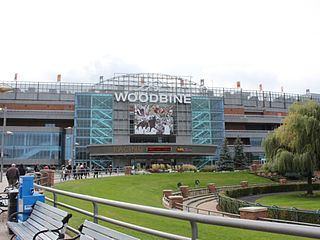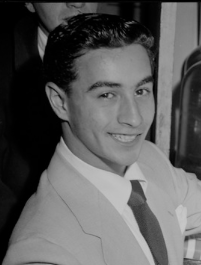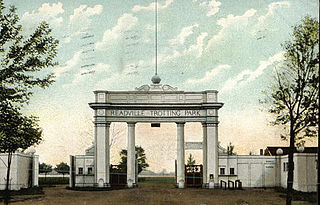
Belmont Park is a thoroughbred horse racetrack in Elmont, New York, just east of New York City limits best known for hosting the Belmont Stakes, the final leg of the American Triple Crown. It was opened on May 4, 1905, and is one of the best well known racetracks in the United States.

In the United States, trolley parks, which started in the 19th century, were picnic and recreation areas along or at the ends of streetcar lines in most of the larger cities. These were precursors to amusement parks. Trolley parks were often created by the streetcar companies to give people a reason to use their services on weekends.

Woodbine Racetrack is a race track for Thoroughbred horse racing in the Etobicoke area of Toronto, Ontario, Canada. Owned by Woodbine Entertainment Group, Woodbine Racetrack manages and hosts Canada's most famous race, the King's Plate. The track was opened in 1956 with a one-mile oval dirt track, as well as a seven-eights turf course. It has been extensively remodeled since 1993, and since 1994 has had three racecourses.

Saratoga Race Course is a Thoroughbred horse racing track located on Union Avenue in Saratoga Springs, New York, United States. Opened in 1863, it is often considered to be the oldest major sporting venue of any kind in the country. It is the oldest thoroughbred race track in the country, but counting harness tracks it is actually the fourth oldest racetrack in the U.S.. In 1857 the Empire Race Course was opened on an island in the Hudson River near Albany, but was in operation only a short time.

Worcester Agricultural Fairgrounds was a 20-acre (8.1 ha) site in Worcester, Massachusetts, in the 19th century. The grounds are mainly known for having hosted the Worcester Worcesters, a professional baseball team of the National League from 1880 to 1882. As a major-league ballpark, the site is usually referred to as Agricultural County Fair Grounds or Worcester Driving Park.
The Breeders' Cup Filly & Mare Turf is a Weight for Age Thoroughbred horse race on turf for fillies and mares, three years old and up. It is held annually at a different racetrack in the United States as part of the Breeders' Cup World Championships.

The Del Mar Fairgrounds is an event venue in Del Mar, California. The fairgrounds hosts the annual San Diego County Fair. The venue sits on a 370-acre (1.5 km2) property along the Pacific Ocean coastline. The Del Mar Racetrack was built in 1936 by the Thoroughbred Club, with founding member Bing Crosby providing leadership. The Del Mar Fairgrounds and Del Mar Thoroughbred Club share one address for the entire complex, 2260 Jimmy Durante Blvd, Del Mar CA 92014.
A graded stakes race is a thoroughbred horse race in the United States that meets the criteria of the American Graded Stakes Committee of the Thoroughbred Owners and Breeders Association (TOBA). A specific grade level is then assigned to the race, based on statistical analysis of the quality of the field in previous years, provided the race meets the minimum purse criteria for the grade in question. In Canada, a similar grading system is maintained by the Jockey Club of Canada. Graded stakes races are similar to Group races in Europe but the grading is more dynamic in North America.

Ramón A. Domínguez is a retired Eclipse Award-winning champion jockey and Hall of Fame member in American thoroughbred horse racing.
Larry Collmus is a Thoroughbred horse racing announcer. A native of Baltimore, Collmus has called at numerous racetracks around the country. He is the race caller for NBC Sports' coverage of the Triple Crown and Breeders' Cup. He previously called races at Gulfstream Park, Monmouth Park, Suffolk Downs and NYRA.

Flatbush Avenue is a bus rapid transit station on the CTfastrak line, located near the intersection of Flatbush Avenue and New Park Avenue in West Hartford, Connecticut. It opened with the line on March 28, 2015. The station consists of one island platform to the side of the busway, with passing lanes to allow express buses to pass buses stopped at the station. A CTrail Hartford Line commuter rail platform is planned to open in 2022 under the name West Hartford.

Anthony DeSpirito was a champion American Thoroughbred horse racing jockey who found instant fame when he won the national riding title in 1952 as an apprentice in his first full year of racing.

Goldsmith Maid was a prominent Standardbred racemare in the 1870s that was called the "Queen of the Trotters" and had a harness racing career that spanned 13 years. Her last race was won at the age of 20 against a much younger horse named Rarus. She was inducted into the Harness Racing Hall of Fame in 1953.

Springbok (1870–1897) was an American Thoroughbred racehorse who won the seventh Belmont Stakes in 1873. Foaled in 1870, he was sired by the imported stallion Australian, his dam was a daughter of Lexington. During his racing career he started 25 races, winning 17 of them. Besides the Belmont, Springbok won the Saratoga Cup twice, in 1874 and 1875 and was named Champion Older Male horse in 1874 and 1875. After retiring from the racetrack, he sired five stakes winners and died in 1897.

The Readville Race Track located in Readville, Massachusetts had a famous and exciting history for Harness Racing, Motorcycle Racing, Auto Racing and early military combat Aviation. When the track officially opened on August 25, 1896, it quickly became one of the premier venues for harness racing in the United States. It was known as one of the country's fastest courses and many records were broken there. In 1903 history was made at Readville when a five-year-old mare named Lou Dillon became the first trotter to run a two-minute mile. On August 25, 1908 the most spectacular event in all harness horse history was staged, the $50,000 American Trotting Derby won by Allan Winter.
Allan James Wilson was a Canadian-born American horse racing executive.

The Grand Circuit, also known as the "Big Wheel", is a group of harness racing stakes races run at various race tracks around the United States. Run on one-mile tracks, it is "the oldest continuing horse-racing series in the United States."

Fleetwood Park was a 19th-century harness racing (trotting) track in what is now the Morrisania section of the Bronx in New York, United States. The races held there were a popular form of entertainment, drawing crowds as large as 10,000 from the surrounding area. The one-mile (1.6 km) course described an unusual shape, with four turns in one direction and one in the other. For the last five years of operation, Fleetwood was part of trotting's Grand Circuit, one travel guide calling it "the most famous trotting track in the country".

Narragansett Park was an American horse and motor racing venue in Cranston, Rhode Island.
Agawam Park was an American horse racing track in Agawam, Massachusetts, that was open from 1935 to 1938, when Hampden County, Massachusetts, voted against parimutuel betting.














